Breaking the Boundary between Permanent Capital Farmland and Arable Land in China: Understanding State and Drivers of Permanent Capital Farmland Non-Grain Production in a Rapid Urbanizing County
Abstract
1. Introduction
2. Background and Analysis Framework
2.1. Relationship between Permanent Capital Farmland (PCF) and Arable Land
2.2. Policy Evolution of PCF
2.3. Analysis Framework
- What is the current structure of PCF?
- Categorized into arable land of permanent capital farmland (arable land of PCF) (a1) and adjustable land (a2) based on attribute structure at the time of PCF demarcation.
- Current state land use identified using high-resolution remote sensing images. The combination of internal and external work identified crop-growing land (b1), current non-crop-growing land (b2), current restored crop-growing land (b3), and current unrestored crop-growing land (b4).
- The arable land of non-permanent capital farmland (arable land of non-PCF) (a3) incorporated into the evaluation system, to screen the current general crop-growing land (b5) in a3 as a potential complement to b4 for satisfying the subsequent PCF non-grain production evaluation.
- What are the manifestations and quantities of PCF non-grain production?
- To divide the crop-growing land of b1, b3, and b5 into grain crop-growing land (c1, c8 and c12) and non-grain crop-growing land (c2, c9 and c13) using TNLS information and visual interpretation.
- To divide b2 into actual occupancy categories according to visual interpretation and labeling, which are forest land occupation (c3), aquaculture pond occupation (c4), tea and fruit orchard land occupation (c5), water body occupation (c6), and construction land occupation (c7).
- To divide b4 into land suitable for the resumption of crop cultivation (c10) and land unsuitable for the resumption of crop cultivation (c11) with the help of the screening conditions defined by the Standard for Well-facilitated Capital Farmland Construction (TD/T 1033-2012) and the Well-facilitated Farmland Construction—General Rules (GB/T 30600-2014).
- What is the state of PCF non-grain production?
- The grain crop-growing land of c1, c8 and c12 are recognized as the land utilized for grain production, and the total area was summarized.
- The non-grain crop-growing land of c2, c9 and c13, the actual occupied land of c3, c4, c5, c6 and c7, and the unrestored crop-growing land of c10 and c11 are recognized as the land utilized for non-grain production utilization, and the total area was summarized.
- The proportion of non-grain production area is used to evaluate the degree of PCF non-grain production. It is calculated as a percentage of the total PCF area of non-grain production, expressed in ‘%’ (Equation (1)).
- Which scenario could objectively represent the state of PCF non-grain production?In fact, b4 is covered by the PCF, but the function of arable land has not assumed since the demarcation of the PCF. Therefore, b4 should not be included in the evaluation of non-grain production in the real plantable area of PCF. However, excluding b4 from the PCF nullifies the condition that the area of PCF must be constant at the county scale, and therefore, in order to express the potential non-grain production of the PCF, it is necessary to supplement it with an equal amount of other arable land (b5). Based on this, three PCF non-grain production evaluation scenarios are proposed.
- Scenario 1 (scenario SD): Categorized as b1 + b2 + b3 + b4 combined, this scenario evaluates the current state of demarcated (SD) PCF non-grain production, reflecting the practical relationship between PCF and arable land, as shown in Figure 2b.
- Scenario 3 (scenario ST): Categorized as b1 + b2 + b3 + b5 combined, this scenario evaluates the theoretical (ST) PCF non-grain production, representing the future state with a constant PCF area after replenishment, as shown in Figure 2a.
3. Research Area and Method
3.1. Research Area
3.2. Data Sources and Drivers Determination
3.2.1. Data Sources
3.2.2. Drivers Determination
3.3. Method
3.3.1. Non-Grain Measurements
3.3.2. Geodetector Modeling
4. Results
4.1. The Structural Characteristics of PCF
4.2. The Characteristics of PCF Non-Grain Production
4.2.1. Scenario Analysis of PCF Non-Grain Production
4.2.2. Spatial Characteristics of Realistic Scenario of PCF Non-Grain Production
4.3. Drivers of PCF Non-Grain Production
4.3.1. Drivers Analysis Based on Geodetector Factor Detection
4.3.2. Explanation of Dominant Factors
5. Discussion and Implications
5.1. PCF Non-Grain Production vs. Arable Land Non-Grain Production
5.1.1. Insights into Differences in the Results of Non-Grain Production
5.1.2. Insights into Differences in the Dominant Land Types for Non-Grain Production
5.1.3. Insights into Differences in the Drivers of Non-Grain Production
5.1.4. Breaking the Boundary between PCF and Arable Land
5.2. Rational Understanding of PCF Non-Grain Production
5.2.1. PCF Non-Grain Production and the Change in Diet Structure
5.2.2. PCF Non-Grain Production and Ecological Conservation
5.3. Policy Direction
5.3.1. PCF Should Be Redefined
5.3.2. More Flexible PCF at Village Scale
5.3.3. More Diverse Economic Incentives at the Village Scale
6. Conclusions
- (1)
- The PCF of Liyang consisted of arable land of PCF and adjustable land, with a ratio of nearly 7:3. The current non-crop-growing land and current unrestored crop-growing land accounted for 33.94% and 27.35% of the PCF, respectively. Within the arable land of PCF, forest land occupation and aquaculture pond occupation contributed to more than 25% of the PCF. Within the adjustable land, the proportion of land unsuitable for resumption of crop cultivation is close to 20% of the PCF.
- (2)
- The average PCF non-grain production for scenarios SD, SR, and ST, which showed the process of transitioning from a practical to a theoretical relationship between PCF and arable land, were 62.88%, 48.88%, and 39.23%, respectively. In particular, scenario SR was congruent with arable status. In this scenario, aquaculture pond occupation and forest land occupation played dominant roles in PCF non-grain production in plain and hilly villages, respectively.
- (3)
- The dominant drivers of PCF area, agricultural income per capita, and urbanization rate were able to explain 51.60%, 42.40%, and 35.30% of PCF non-grain production, respectively. PCF area had a positive effect on non-grain production, attributed to the relationship between PCF and general arable land in villages. Agricultural income per capita had a positive effect on non-grain production, attributed to the low comparative returns to grain production. Urbanization rate had a negative impact on non-grain production, attributed to the arable land reserved for development.
Author Contributions
Funding
Data Availability Statement
Acknowledgments
Conflicts of Interest
References
- Wu, Y.; Shan, L.; Guo, Z.; Peng, Y. Cultivated land protection policies in China facing 2030: Dynamic balance system versus basic farmland zoning. Habitat Int. 2017, 69, 126–138. [Google Scholar] [CrossRef]
- Wu, S.; Wang, D. Storing grain in the land: The gestation, delineation framework, and case of the two zones policy in China. Land 2023, 12, 806. [Google Scholar] [CrossRef]
- Cheng, Q.; Jiang, P.; Cai, L.; Shan, J.; Zhang, Y.; Wang, L.; Li, M.; Li, F.; Zhu, A.; Chen, D. Delineation of a permanent basic farmland protection area around a city centre: Case study of Changzhou City, China. Land Use Policy 2017, 60, 73–89. [Google Scholar] [CrossRef]
- Bren d’Amour, C.; Reitsma, F.; Baiocchi, G.; Barthel, S.; Güneralp, B.; Erb, K.H.; Haberl, H.; Creutzig, F.; Seto, K.C. Future urban land expansion and implications for global croplands. Proc. Natl. Acad. Sci. USA 2017, 114, 8939–8944. [Google Scholar] [CrossRef]
- Sheng, Y.; Song, L. Agricultural production and food consumption in China: A long-term projection. China Econ. Rev. 2019, 53, 15–29. [Google Scholar] [CrossRef]
- Kong, X. Problems, causes and countermeasures of arable land non-grain. China Land 2020, 11, 17–19. [Google Scholar] [CrossRef]
- Zhu, D. Economic mechanisms and governance paths for arable land non-grain. China Land 2021, 7, 9–11. [Google Scholar] [CrossRef]
- Su, Y.; Li, C.; Wang, K.; Deng, J.; Shahtahmassebi, A.R.; Zhang, L.; Ao, W.; Guan, T.; Pan, Y.; Gan, M. Quantifying the spatiotemporal dynamics and multi-aspect performance of non-grain production during 2000–2015 at a fine scale. Ecol. Indic. 2019, 101, 410–419. [Google Scholar] [CrossRef]
- Zhang, D.; Yang, W.; Kang, D.; Zhang, H. Spatial-temporal characteristics and policy implication for non-grain production of cultivated land in Guanzhong Region. Land Use Policy 2023, 125, 106466. [Google Scholar] [CrossRef]
- Zhu, Z.; Duan, J.; Li, S.; Dai, Z.; Feng, Y. Phenomenon of non-grain production of cultivated land has become increasingly prominent over the last 20 years: Evidence from Guanzhong Plain, China. Agriculture 2022, 12, 1654. [Google Scholar] [CrossRef]
- Zhang, Y.; Feng, Y.; Wang, F.; Chen, Z.; Li, X. Spatiotemporal differentiation and driving mechanism of cultivated land non-grain conversion in Guangdong Province. Resour. Sci. 2022, 44, 480–493. [Google Scholar] [CrossRef]
- Chen, W.; Liao, Y.; Kong, X.; Lei, M.; Wen, L.; Zhang, B. Characteristics, drivers and control of non-grain production on permanent basic farmland based on plot scale. Trans. Chin. Soc. Agric. Mach. 2023, 54, 114–124. [Google Scholar] [CrossRef]
- Wang, J.; Dai, C. Identifying the spatial-temporal pattern of cropland’s non-grain production and its effects on food security in China. Foods 2022, 11, 3494. [Google Scholar] [CrossRef] [PubMed]
- Gu, Z.; Jin, X.; Liang, X.; Liu, J.; Han, B.; Zhou, Y. Diversification of food production in rapidly urbanizing areas of China, evidence from southern Jiangsu. Sustain. Cities Soc. 2024, 101, 105121. [Google Scholar] [CrossRef]
- Chen, S.; Zhang, Y.; Zhu, Y.; Ma, L.; Zhao, J. The battle of crops: Unveiling the shift from grain to non-grain use of farmland in China? Int. J. Agric. Sustain. 2023, 21, 2262752. [Google Scholar] [CrossRef]
- Cheng, X.; Tao, Y.; Huang, C.; Yi, J.; Yi, D.; Wang, F.; Tao, Q.; Xi, H.; Ou, W. Unraveling the causal mechanisms for non-grain production of cultivated land: An analysis framework applied in Liyang, China. Land 2022, 11, 1888. [Google Scholar] [CrossRef]
- Yang, Q.; Zhang, D. The influence of agricultural industrial policy on non-grain production of cultivated land: A case study of the “one village, one product” strategy implemented in Guanzhong Plain of China. Land Use Policy 2021, 108, 105579. [Google Scholar] [CrossRef]
- Ren, G.; Song, G.; Wang, Q.; Sui, H. Impact of “non-Grain” in cultivated land on agricultural development resilience: A case study from the major grain-producing area of Northeast China. Appl. Sci. 2023, 13, 3814. [Google Scholar] [CrossRef]
- Zhou, S.; Zhao, X. Adjustment and optimization of permanent capital farmland based on comprehensive quality of arable land: A case study of Yiling District, Hubei Province. Nongcun Shiyong Jishu 2021, 8, 11–12. Available online: https://kns.cnki.net/kcms2/article/abstract?v=3uoqIhG8C44YLTlOAiTRKibYlV5Vjs7iy_Rpms2pqwbFRRUtoUImHS9kVDVpr6C68Ylj27C7OLz4sM_b_1mUHyg0tHwmLEC5&uniplatform=NZKPT (accessed on 31 March 2022).
- Zhang, Q. Assessment of the current situation of agricultural space arable land and permanent capital farmland protection: A case study of Longling County. Shanxi Agric. Econ. 2022, 3, 160–162. [Google Scholar] [CrossRef]
- Chen, F.; Liu, J.; Chang, Y.; Zhang, Q.; Yu, H.; Zhang, S. Spatial pattern differentiation of non-grain cultivated land and its driving factors in China. China Land Sci. 2021, 35, 33–43. [Google Scholar] [CrossRef]
- Qian, F.; Wang, Q.; Bian, Z.; Dong, X. Discussion about the permanent basic farmland planning and protection. Chin. J. Agric. Resour. Reg. Plan. 2013, 34, 22–27. [Google Scholar] [CrossRef]
- Zhang, Y. Insisting on green development to ensure high-quality development—Survey on the current situation of development land and permanent capital farmland protection in Cangwu County’s new county towns. NanFang ZiRan ZiYuan 2020, 1, 40–44. [Google Scholar] [CrossRef]
- Qiao, L. Reflections on the demarcation of permanent capital farmland based on the prioritization of arable land protection. China Land 2021, 9, 21–24. [Google Scholar] [CrossRef]
- Mao, Y. Survey and identification of arable land in the Third National Land Survey. West. Resour. 2021, 6, 166–168. [Google Scholar] [CrossRef]
- Su, Y.; Qian, K.; Lin, L.; Wang, K.; Guan, T.; Gan, M. Identifying the driving forces of non-grain production expansion in rural China and its implications for policies on cultivated land protection. Land Use Policy 2020, 92, 104435. [Google Scholar] [CrossRef]
- Wu, Y.; Zhang, P.; Yu, Y.; Xie, R. Progress review on and prospects for non-grain cultivated land in China from the perspective of food security. China Land Sci. 2021, 35, 116–124. [Google Scholar] [CrossRef]
- Liu, Y.; Zhou, Y. Reflections on China’s food security and land use policy under rapid urbanization. Land Use Policy 2021, 109, 105699. [Google Scholar] [CrossRef]
- Chen, Y.; Li, M.; Zhang, Z. Does the rural land transfer promote the non-grain production of cultivated land in China? Land 2023, 12, 688. [Google Scholar] [CrossRef]
- Liu, G.; Zhao, L.; Chen, H.; Zhou, Y.; Lin, H.; Wang, C.; Huang, H.; Li, X.; Yuan, Z. Does farmland transfer lead to non-grain production in agriculture?—An empirical analysis based on the differentiation of farmland renting-in objects. Sustainability 2022, 15, 379. [Google Scholar] [CrossRef]
- Yang, A.; Wang, Y. Spatiotemporal variations in farmland rents and its drivers in rural China: Evidence from plot-level transactions. Land 2022, 11, 229. [Google Scholar] [CrossRef]
- Zhu, J.; Li, X. Evaluation and policy enlightenment of permanent basic farmland protection: A case study of XX prefecture-level city in eastern China. Resour. Dev. Mark. 2021, 37, 405–409. [Google Scholar] [CrossRef]
- Qi, Y.; Hou, Y.; Li, Y.; Li, L.; Zhang, J.; Chang, Y.; Zhu, D. The price gap between state-owned and collective farmlands: Evidence from Xinjiang and Heilongjiang, China. Land Use Policy 2023, 124, 106460. [Google Scholar] [CrossRef]
- Meng, F. Whether the land management right of permanent capital farmland can be changed for other purposes after transferring it. China Land 2021, 9, 61. [Google Scholar] [CrossRef]
- Wang, Q.; Xiong, Y. The influence of policy fragmentation on the “non-grainization” of cultivated land and its countermeasures: Y Town, J District, Z City as a case study. J. Hunan Univ. Technol. (Soc. Sci. Ed.) 2022, 27, 17–23. [Google Scholar] [CrossRef]
- Su, M.; Guo, R.; Hong, W. Institutional transition and implementation path for cultivated land protection in highly urbanized regions: A case study of Shenzhen, China. Land Use Policy 2019, 81, 493–501. [Google Scholar] [CrossRef]
- Kong, X.; Dang, Y. Internal logic and reflection on the evolution of the permanent capital farmland system. China Land 2022, 5, 12–15. [Google Scholar] [CrossRef]
- Liao, L.; Long, H.; Gao, X.; Ma, E. Effects of land use transitions and rural aging on agricultural production in China’s farming area: A perspective from changing labor employing quantity in the planting industry. Land Use Policy 2019, 88, 104152. [Google Scholar] [CrossRef]
- Yu, H.; Liu, K.; Bai, Y.; Luo, Y.; Wang, T.; Zhong, J.; Liu, S.; Bai, Z. The agricultural planting structure adjustment based on water footprint and multi-objective optimisation models in China. J. Clean. Prod. 2021, 297, 126646. [Google Scholar] [CrossRef]
- He, X.; Zhong, J.; Lin, S.; Dai, R.; He, Z.; Shi, Q. Characteristics and driving mechanism of spatial differentiation of “Non-grain” cultivated land in karst trough valley area: Taking Wanshan District, Tongren, Guizhou as an example. Sci. Geogr. Sin. 2022, 42, 2207–2217. [Google Scholar] [CrossRef]
- Zhu, Z.; Dai, Z.; Li, S.; Feng, Y. Spatiotemporal evolution of non-grain production of cultivated land and its underlying factors in China. Int. J. Environ. Res. Public Health 2022, 19, 8210. [Google Scholar] [CrossRef] [PubMed]
- Chen, S.; Yu, S. Analysis on land use change and its driving force in the Yangtze River Delta region during 1985-2015. Forestry Econ. 2019, 41, 49–54. [Google Scholar] [CrossRef]
- Sun, Y.; Chang, Y.; Liu, J.; Ge, X.; Liu, G.J.; Chen, F. Spatial differentiation of non-grain production on cultivated land and its driving factors in coastal China. Sustainability 2021, 13, 13064. [Google Scholar] [CrossRef]
- Cheng, L.; Jiang, P.; Chen, W.; Li, M.; Wang, L.; Gong, Y.; Pian, Y.; Xia, N.; Duan, Y.; Huang, Q. Farmland protection policies and rapid urbanization in China: A case study for Changzhou City. Land Use Policy 2015, 48, 552–566. [Google Scholar] [CrossRef]
- Li, Y.; Zhao, B.; Huang, A.; Xiong, B.; Song, C. Characteristics and driving forces of non-grain production of cultivated land from the perspective of food security. Sustainability 2021, 13, 14047. [Google Scholar] [CrossRef]
- Shi, Y.; Li, H.; Akida, A.; Geng, J.; Zhang, W.; Pang, J. Unraveling safe boundaries for net anthropogenic nitrogen inputs: A case study focusing on village scale. J. Clean. Prod. 2024, 434, 140462. [Google Scholar] [CrossRef]
- Lichtenberg, E.; Ding, C. Assessing farmland protection policy in China. Land Use Policy 2008, 25, 59–68. [Google Scholar] [CrossRef]
- Liu, X.; Zhao, C.; Song, W. Review of the evolution of cultivated land protection policies in the period following China’s reform and liberalization. Land Use Policy 2017, 67, 660–669. [Google Scholar] [CrossRef]
- Chen, W.; Zhang, Q.; Kong, X.; Duan, X.; Zuo, X.; Tan, M.; Zhao, J.; Dong, T. Optimizing rules and empirical research of provincial permanent basic farmland layout based on the “Three-line” coordination. Trans. Chin. Soc. Agric. Eng. 2021, 37, 248–257. [Google Scholar] [CrossRef]
- Chang, Y.; Liu, J.; Zhang, Q.; Yu, H.; Bian, Z.; Chen, F. Spatial pattern differentiation of cultivated land non-grain conversion in major grain-producing areas. J. Agric. Resour. Environ. 2022, 39, 817–826. [Google Scholar] [CrossRef]
- Liang, X.; Jin, X.; Liu, J.; Yin, Y.; Gu, Z.; Zhang, J.; Zhou, Y. Formation mechanism and sustainable productivity impacts of non-grain croplands: Evidence from Sichuan Province, China. Land Degrad. Dev. 2023, 34, 1120–1132. [Google Scholar] [CrossRef]
- Zhao, X.; Zheng, Y.; Huang, X.; Kwan, M.P.; Zhao, Y. The effect of urbanization and farmland transfer on the spatial patterns of non-grain farmland in China. Sustainability 2017, 9, 1438. [Google Scholar] [CrossRef]
- Meng, F.; Tan, Y.; Chen, H.; Xiong, W. Spatial-temporal evolution patterns and influencing factors of “non-grain” utilization of cultivated land in China. China Land Sci. 2022, 36, 97–106. [Google Scholar] [CrossRef]
- Wu, Y.; Yuan, C.; Liu, Z.; Wu, H.; Wei, X. Decoupling relationship between the non-grain production and intensification of cultivated land in China based on Tapio decoupling model. J. Clean. Prod. 2023, 424, 138800. [Google Scholar] [CrossRef]
- Wang, J.; Xu, C. Geodetector: Principles and prospects. Acta Geogr. Sin. 2017, 72, 116–134. [Google Scholar] [CrossRef]
- Chen, Y.; Wang, G.; Wang, L. Change mechanism of China’s grain production from the perspective of peasant household’s decision behavior. Econ. Geogr. 2016, 36, 139–145. [Google Scholar] [CrossRef]
- Du, Z.; Hang, L. The impact of production-side changes in grain supply on China’s food security. Chin. Rural. Econ. 2020, 4, 2–14. Available online: http://crecrs-zgncjj.ajcass.org/Magazine/Show/71809 (accessed on 31 March 2022).
- Gerbens-Leenes, P.W.; Nonhebel, S.; Krol, M.S. Food consumption patterns and economic growth. Increasing affluence and the use of natural resources. Appetite 2010, 55, 597–608. [Google Scholar] [CrossRef] [PubMed]
- Yang, W.; Luan, Y.; Yang, C.; Cui, X. Changes in the land requirements for food from 1961 to 2007 in China. Resour. Sci. 2013, 35, 901–909. [Google Scholar]
- Zhao, M.; Shi, H.; Li, X.; Alfonso, M.; Yao, Y.; Wang, J.; Bi, Y. Multi-scale regional analysis for differences on residents’ food consumption and policy implications: An empirical study on family recipes in Yantai, Lanzhou, Xinxiang and Jiujiang. J. Nat. Resour. 2022, 37, 2636–2650. [Google Scholar] [CrossRef]
- Fukase, E.; Martin, W. Economic growth, convergence, and world food demand and supply. World Dev. 2020, 132, 104954. [Google Scholar] [CrossRef]
- Song, X.; Wang, X.; Li, X.; Zhang, W.; Scheffran, J. Policy-oriented versus market-induced: Factors influencing crop diversity across China. Ecol. Econ. 2021, 190, 107184. [Google Scholar] [CrossRef]
- Liu, C.; Huo, Y.; Xu, Y.; Huang, A.; Sun, P.; Lu, L. Changes in cultivated land and influencing factors before and after the implementation of grain for green project in Zhangjiakou City. J. Nat. Resour. 2018, 33, 1806–1820. [Google Scholar] [CrossRef]
- Zong, R.; Zeng, Y.; Fang, N.; Shi, Z. Spatially optimized cropland distribution promotes sustainable farming and vegetation restoration in mountainous regions. Land Degrad. Dev. 2022, 33, 3954–3964. [Google Scholar] [CrossRef]
- Wang, L.; Wang, S.; Zhou, Y.; Zhu, J.; Zhang, J.; Hou, Y.; Liu, W. Landscape pattern variation, protection measures, and land use/land cover changes in drinking water source protection areas: A case study in Danjiangkou Reservoir, China. Glob. Ecol. Conserv. 2020, 21, e00827. [Google Scholar] [CrossRef]
- Pueppke, S.G.; Zhang, W.; Li, H.; Chen, D.; Ou, W. An integrative framework to control nutrient loss: Insights from two hilly basins in China’s Yangtze River Delta. Water 2019, 11, 2036. [Google Scholar] [CrossRef]
- Wen, L.; Lin, Z. Legislative perfection of permanent basic farmland protection in China under the background of rural revitalization. J. Xi’an Univ. Financ. Econ. 2021, 34, 100–110. [Google Scholar] [CrossRef]
- Yi, F.; Sun, D.; Zhou, Y. Grain subsidy, liquidity constraints and food security—Impact of the grain subsidy program on the grain-sown areas in China. Food Policy 2015, 50, 114–124. [Google Scholar] [CrossRef]
- Xue, X.; Zhang, Y. Current situation, causes and countermeasures regarding non-grain growing of farmland in major grain-producing counties. Acad. J. Zhongzhou 2017, 8, 40–45. [Google Scholar] [CrossRef]
- Xu, X.; Peng, H.; Xu, Q.; Xiao, H.; Benoit, G. Land changes and conflicts coordination in coastal urbanization: A case study of the Shandong Peninsula in China. Coast. Manag. 2009, 37, 54–69. [Google Scholar] [CrossRef]
- Behnisch, M.; Krüger, T.; Jaeger, J.A. Rapid rise in urban sprawl: Global hotspots and trends since 1990. PLoS Sustain. Transform. 2022, 1, e0000034. [Google Scholar] [CrossRef]
- Yang, L.; Fang, C.; Chen, W.; Zeng, J. Urban-rural land structural conflicts in China: A land use transition perspective. Habitat Int. 2023, 138, 102877. [Google Scholar] [CrossRef]
- Zheng, H.; Liu, Y.; Zhao, J. Understanding water rights and water trading systems in China: A systematic framework. Water Secur. 2021, 13, 100094. [Google Scholar] [CrossRef]
- Nie, X.; Yang, M.; Chen, Z.; Li, W.; Zang, R.; Wang, H. Should government play a strict or lenient role? An evolutionary game analysis of implementing the forest ecological bank policy. Forests 2023, 14, 1002. [Google Scholar] [CrossRef]
- Li, M.; Gan, C.; Ma, W.L.; Jiang, W. Impact of cash crop cultivation on household income and migration decisions: Evidence from low-income regions in China. J. Integr. Agric. 2020, 19, 2571–2581. [Google Scholar] [CrossRef]
- Huang, Z. Is “family farms” the way to develop Chinese agriculture? Open Times 2014, 2, 176–194+9. [Google Scholar]
- Wilmsen, B.; Rogers, S.; van Hulten, A.; Yuefang, D. In the shadow of state-led agrarian reforms: Smallholder pervasiveness in rural China. Agric. Hum. Values 2024, 41, 75–90. [Google Scholar] [CrossRef]
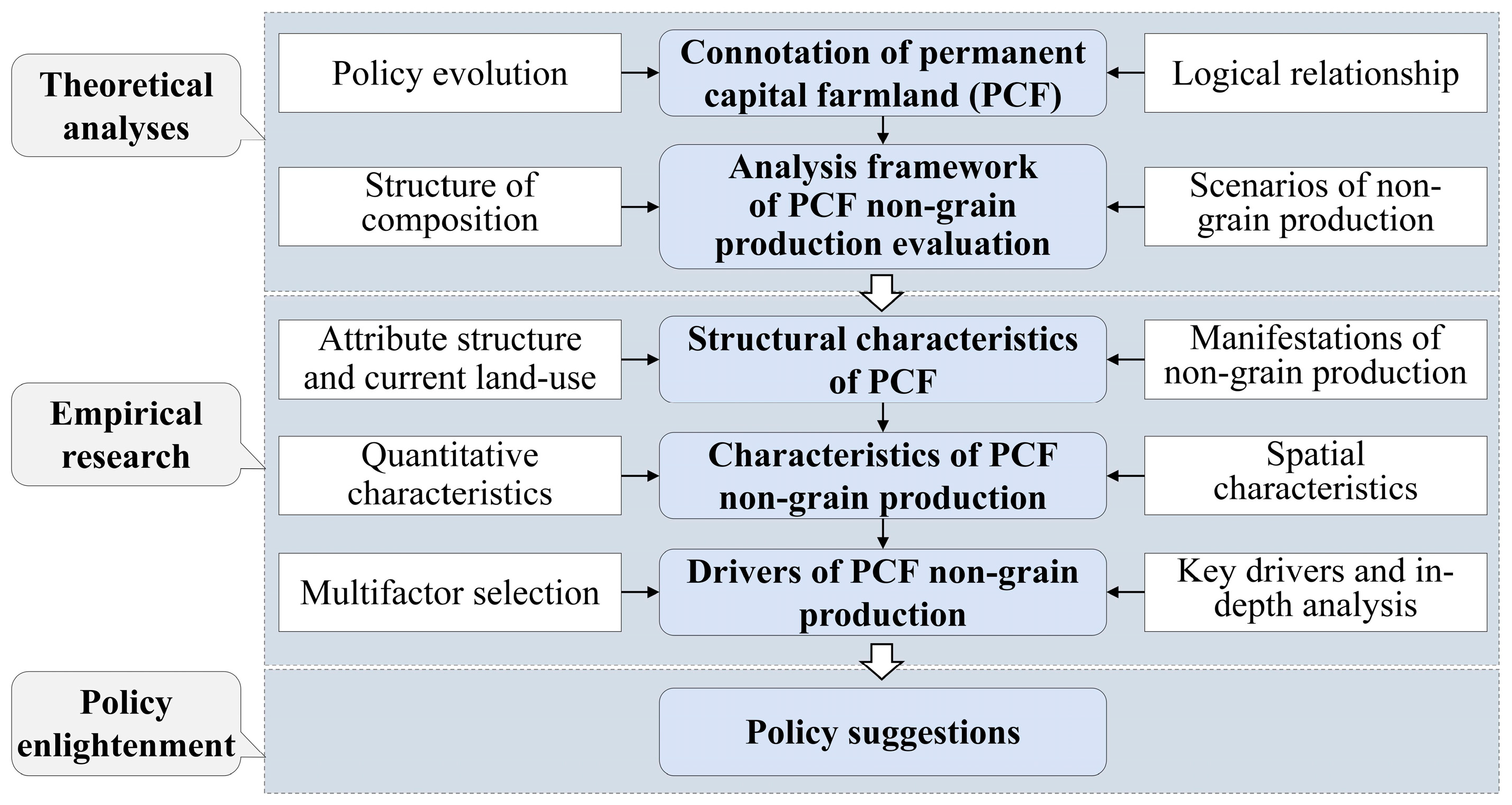
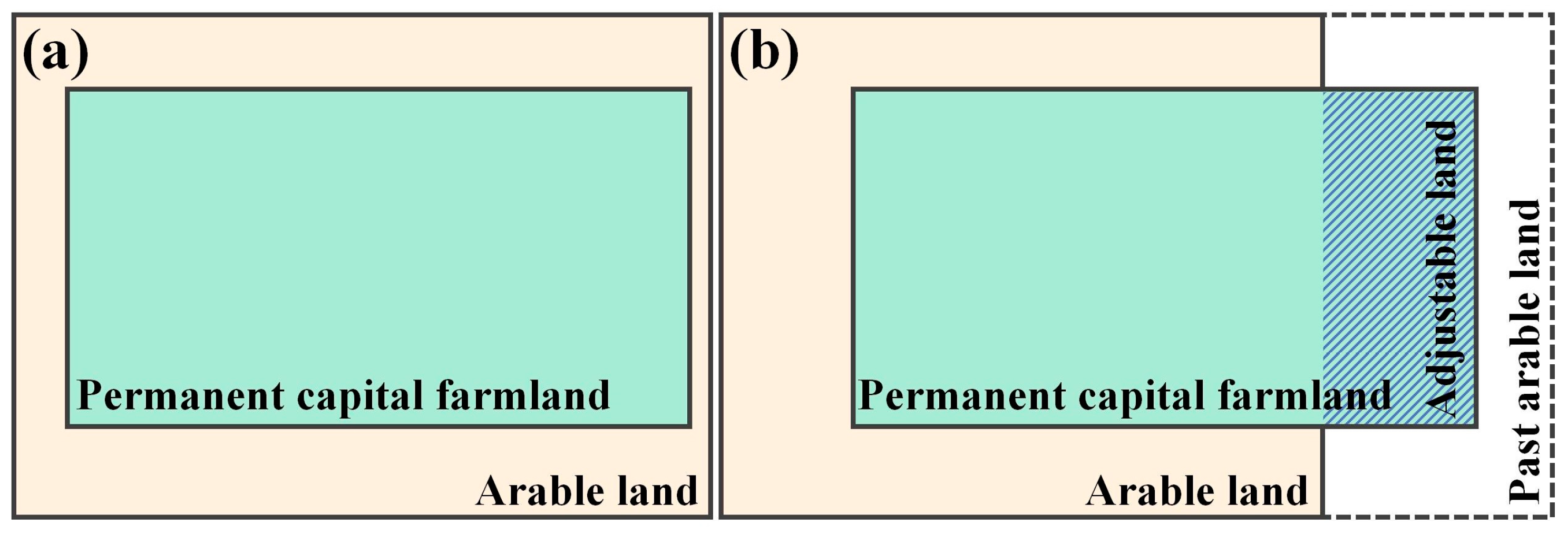

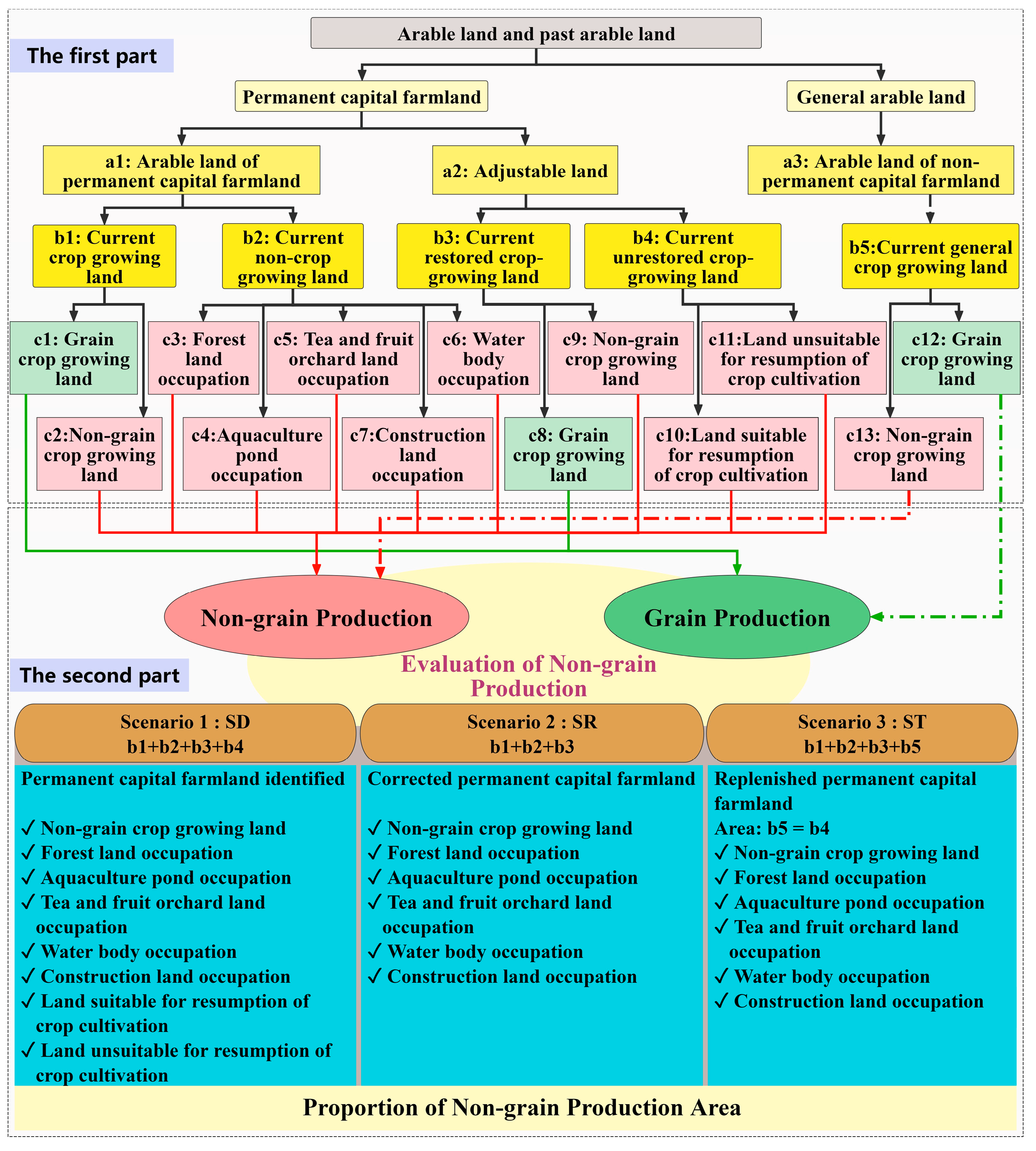
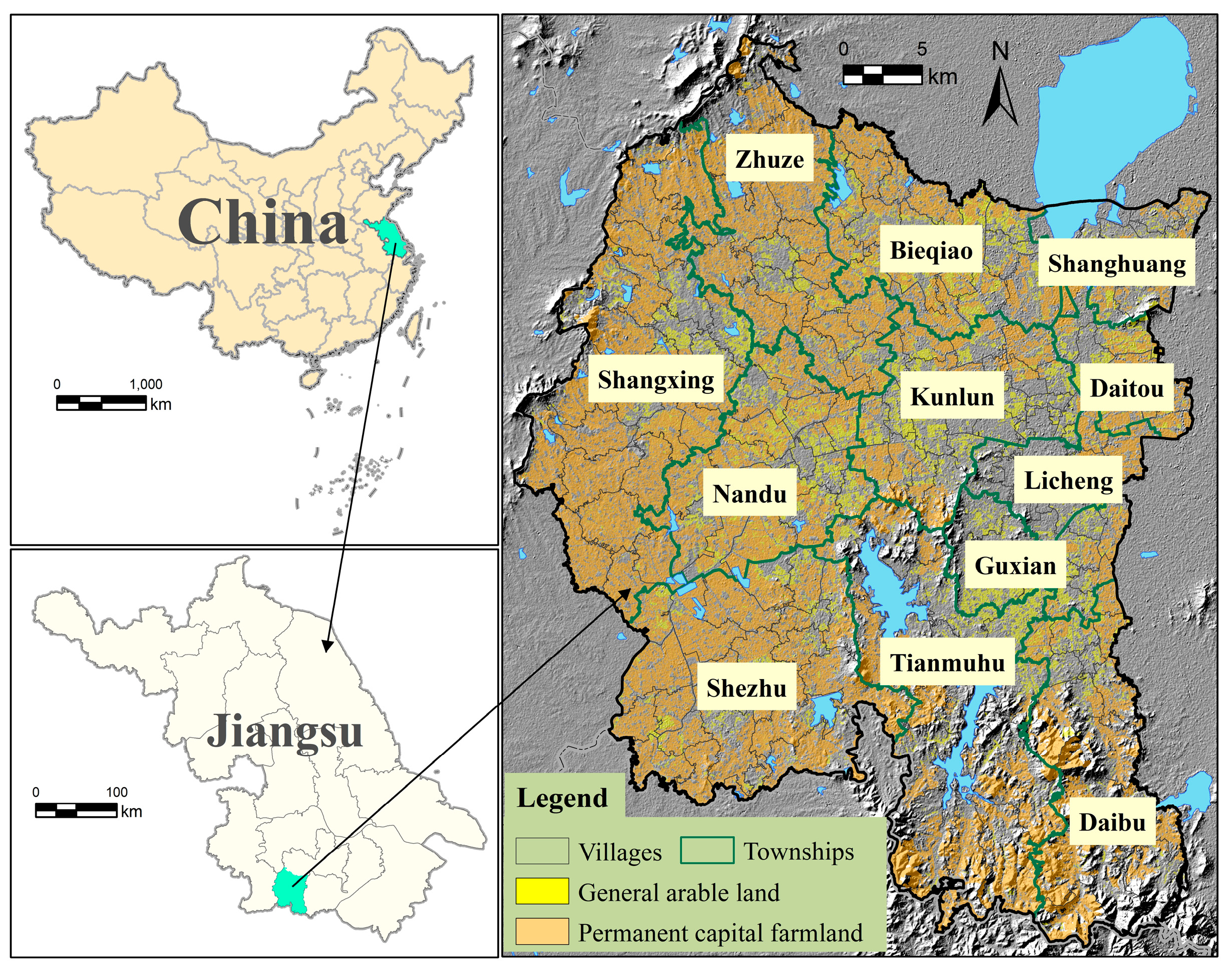
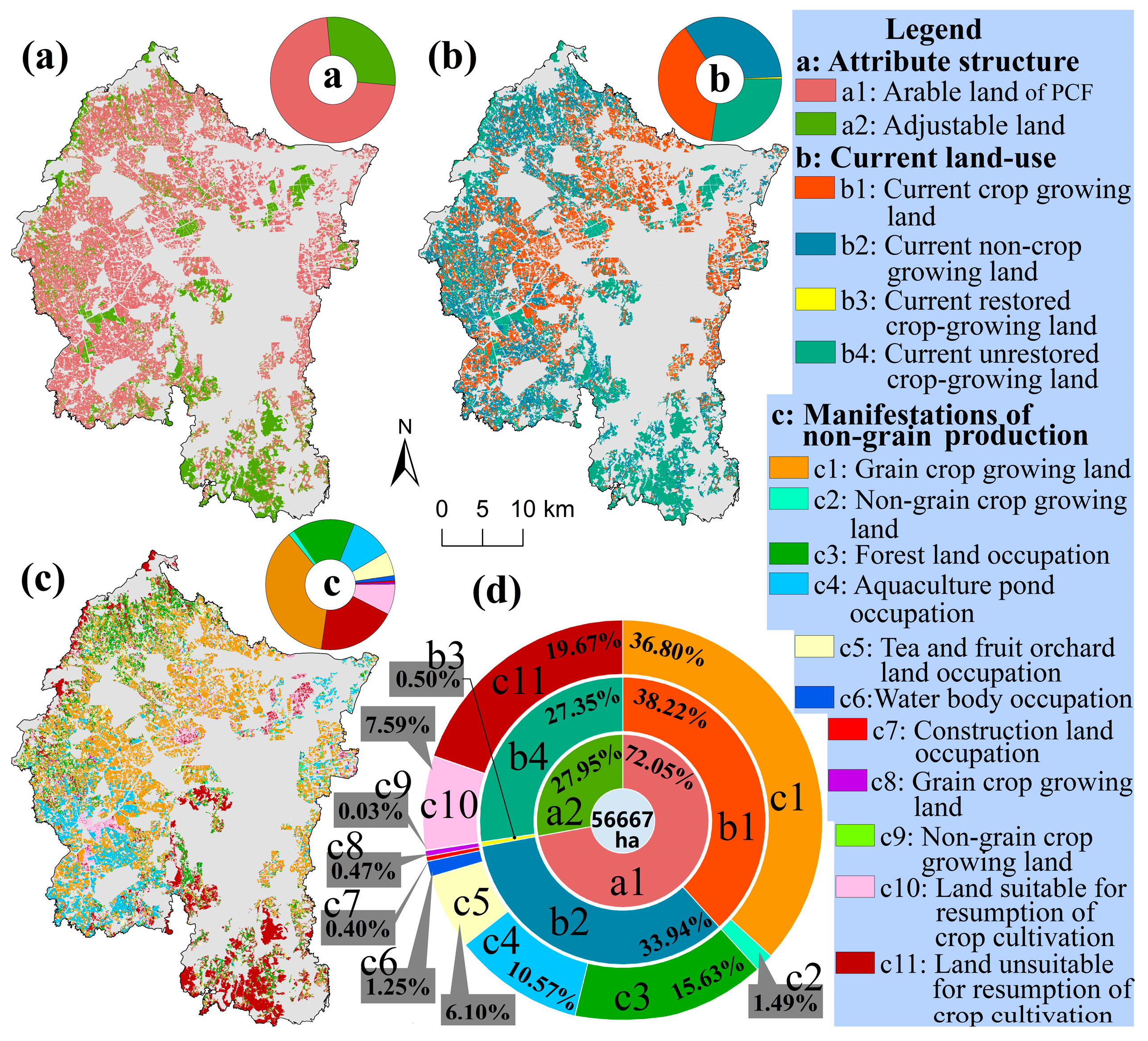



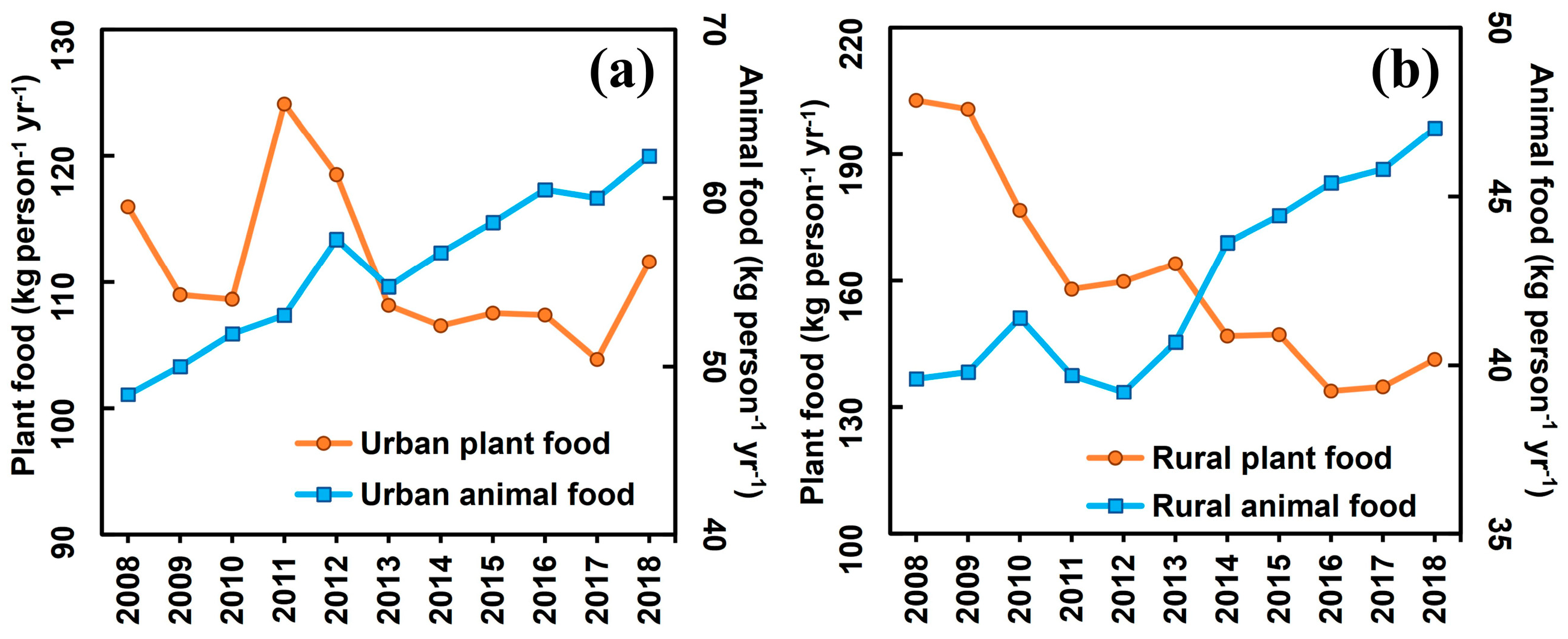
| Data Name | List of Main Data | Data Time | Data Sources |
|---|---|---|---|
| PCF data | PCF data | 2017 | Liyang Natural Resources and Planning Bureau |
| Remote sensing data | Gaofen-2 satellite (GF-2) data | 2019 | Liyang Natural Resources and Planning Bureau |
| Digital elevation model (DEM) data | 2014 | https://search.asf.alaska.edu/#/ (accessed on 4 April 2022) | |
| Land use data | Third National Land Survey in China (TNLS) data | 2019 | Liyang Natural Resources and Planning Bureau |
| Social and economic data | Liyang Statistical Yearbook | 2017–2022 | Liyang Statistics Bureau |
| Statistical Bulletin of National Economic and Social Development of Liyang | 2019 | https://www.liyang.gov.cn/html/czly/2020/OFCPQFIA_0513/4582.html (accessed on 6 May 2022) | |
| Third National Agricultural Census | 2016 | Liyang Agriculture and Rural Affairs Bureau | |
| Table of Basic Social and Economic Conditions of the Village | 2019 | Liyang Statistics Bureau | |
| Costs and Benefits of Major Agricultural Operations in Liyang | 2018–2022 | Liyang Price Bureau; Local farmer research |
| Type | Factors | Unit | Variable | References |
|---|---|---|---|---|
| Economic factors | Added value of the primary industry | CHY | X1 | [14,43,45] |
| Agricultural income per capita | CHY person−1 | X2 | [29,43,50] | |
| Aquaculture income per capita | CHY person−1 | X3 | [29,45,50] | |
| Social factors | Agricultural population | Persons | X4 | [14,21,29,43,50] |
| Non-agricultural population | Persons | X5 | [14,50] | |
| Urbanization rate | % | X6 | [13,21,43,45] | |
| Resource factors | Total power of agricultural machinery | 104 kw | X7 | [13,21,43,50] |
| PCF area | ha | X8 | [13,21] | |
| Mean slope | ° | X9 | [9,13,14,40,43] | |
| Policy factors | Arable land area transferred | ha | X10 | [16,21,29,50] |
| Number of agricultural cooperatives | Number | X11 | [21,43,50] | |
| Policy insurance participation rate | % | X12 | [53] |
| Item | Unit | Rice/Wheat | Rice/Rapeseed | Tea | Shrimp |
|---|---|---|---|---|---|
| Benefits 1 | CNY ha−1 yr−1 | 40,882 | 45,057 | 162,073 | 162,000 |
| Costs 2 | CNY ha−1 yr−1 | 22,895 | 23,010 | 130,776 | 145,680 |
| Cash earning 3 | CNY ha−1 yr−1 | 21,936 | 28,302 | 45,129 | 43,770 |
| Cash outlay 4 | CNY ha−1 yr−1 | 18,947 | 16,755 | 116,944 | 118,230 |
Disclaimer/Publisher’s Note: The statements, opinions and data contained in all publications are solely those of the individual author(s) and contributor(s) and not of MDPI and/or the editor(s). MDPI and/or the editor(s) disclaim responsibility for any injury to people or property resulting from any ideas, methods, instructions or products referred to in the content. |
© 2024 by the authors. Licensee MDPI, Basel, Switzerland. This article is an open access article distributed under the terms and conditions of the Creative Commons Attribution (CC BY) license (https://creativecommons.org/licenses/by/4.0/).
Share and Cite
Shi, Y.; Li, H.; Geng, J.; Askar, A.; Zhao, Z.; Pang, J.; Zhang, W.; Shao, Y. Breaking the Boundary between Permanent Capital Farmland and Arable Land in China: Understanding State and Drivers of Permanent Capital Farmland Non-Grain Production in a Rapid Urbanizing County. Land 2024, 13, 1226. https://doi.org/10.3390/land13081226
Shi Y, Li H, Geng J, Askar A, Zhao Z, Pang J, Zhang W, Shao Y. Breaking the Boundary between Permanent Capital Farmland and Arable Land in China: Understanding State and Drivers of Permanent Capital Farmland Non-Grain Production in a Rapid Urbanizing County. Land. 2024; 13(8):1226. https://doi.org/10.3390/land13081226
Chicago/Turabian StyleShi, Yunjie, Hengpeng Li, Jianwei Geng, Akida Askar, Zhongjing Zhao, Jiaping Pang, Wangshou Zhang, and Yuyang Shao. 2024. "Breaking the Boundary between Permanent Capital Farmland and Arable Land in China: Understanding State and Drivers of Permanent Capital Farmland Non-Grain Production in a Rapid Urbanizing County" Land 13, no. 8: 1226. https://doi.org/10.3390/land13081226
APA StyleShi, Y., Li, H., Geng, J., Askar, A., Zhao, Z., Pang, J., Zhang, W., & Shao, Y. (2024). Breaking the Boundary between Permanent Capital Farmland and Arable Land in China: Understanding State and Drivers of Permanent Capital Farmland Non-Grain Production in a Rapid Urbanizing County. Land, 13(8), 1226. https://doi.org/10.3390/land13081226









